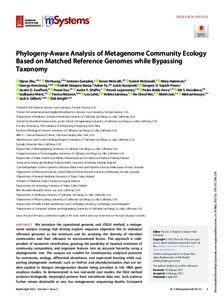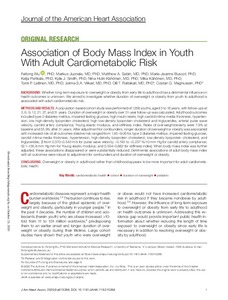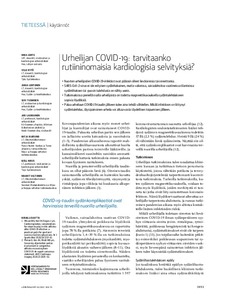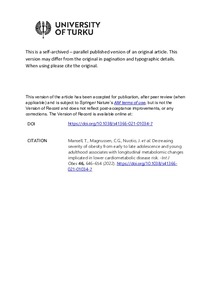Hae
Aineistot 21-30 / 97
Phylogeny-Aware Analysis of Metagenome Community Ecology Based on Matched Reference Genomes while Bypassing Taxonomy
<p>We introduce the operational genomic unit (OGU) method, a metagenome analysis strategy that directly exploits sequence alignment hits to individual reference genomes as the minimum unit for assessing the diversity of ...
Worldwide trends in hypertension prevalence and progress in treatment and control from 1990 to 2019: a pooled analysis of 1201 population-representative studies with 104 million participants
<p><br></p><p>Background: Hypertension can be detected at the primary health-care level and low-cost treatments can effectively control hypertension. We aimed to measure the prevalence of hypertension and progress in its ...
Sydän- ja verisuonitautien ehkäisy kannattaa aloittaa jo vauvasta - STRIP-tutkimus näyttää miksi ja miten
Satunnaistetussa STRIP-tutkimuksessa 562 tervettä lasta sai tyydyttyneen rasvan saannin vähentämiseen tähtäävää ravitsemusneuvontaa kahdeksan kuukauden iästä alkaen 20 vuoden ikään asti, ja 545 saman ikäistä lasta seurattiin ...
Genetic and observational evidence: No independent role for cholesterol efflux over static high-density lipoprotein concentration measures in coronary heart disease risk assessment
<p>Background <br></p><p>Observational findings for high-density lipoprotein (HDL)-mediated cholesterol efflux capacity (HDL-CEC) and coronary heart disease (CHD) appear inconsistent, and knowledge of the genetic architecture ...
Does better education mitigate risky health behavior? A mendelian randomization study
<p><br></p><p>Education and risky health behaviors are strongly negatively correlated. Education may affect health behaviors by enabling healthier choices through higher disposable income, increasing information about the ...
Association of Body Mass Index in Youth With Adult Cardiometabolic Risk
<div>Background: Whether long-term exposure to overweight or obesity from early life to adulthood has a detrimental influence on health outcomes is unknown. We aimed to investigate whether duration of overweight or obesity ...
Urheilijan COVID-19 : tarvitaanko rutiininomaisia kardiologisia selvityksiä?
<p>Nuorten urheilijoiden COVID-19-infektiot ovat pääosin olleet lieväoireisia tai oireettomia. SARS-CoV-2-virus ei ole erityisen sydänhakuinen, mutta vaikeissa, sairaalahoitoa vaatineissa tilanteissa sydänlihaksen tai ...
Fatty liver index predicts incident risk of prediabetes, type 2 diabetes and non-alcoholic fatty liver disease (NAFLD)
Aims To investigate the association between overweight/obesity and fatty liver index (FLI) on the odds of incident prediabetes/type 2 diabetes and non-alcoholic fatty liver disease (NAFLD) in 2020 participants after 10 ...
Short- and long-term outcomes of infective endocarditis admission in adults: A population-based registry study in Finland
<p>Infective endocarditis (IE) is associated with high mortality. However, data on factors associated with length of stay (LOS) in hospital due to IE are scarce. In addition, long-term mortality of more than 1 year is ...
Decreasing severity of obesity from early to late adolescence and young adulthood associates with longitudinal metabolomic changes implicated in lower cardiometabolic disease risk
<p><strong>Background </strong><br>Obesity in childhood is associated with metabolic dysfunction, adverse subclinical cardiovascular phenotypes and adult cardiovascular disease. Longitudinal studies of youth with obesity investigating changes in severity of obesity with metabolomic profiles are sparse. We investigated associations between (i) baseline body mass index (BMI) and follow-up metabolomic profiles; (ii) change in BMI with follow-up metabolomic profiles; and (iii) change in BMI with change in metabolomic profiles (mean interval 5.5 years). <br></p><p><strong>Methods </strong><br>Participants (n = 98, 52% males) were recruited from the Childhood Overweight Biorepository of Australia study. At baseline and follow-up, BMI and the % >95th BMI-centile (percentage above the age-, and sex-specific 95th BMI-centile) indicate severity of obesity, and nuclear magnetic resonance spectroscopy profiling of 72 metabolites/ratios, log-transformed and scaled to standard deviations (SD), was performed in fasting serum. Fully adjusted linear regression analyses were performed.<br></p><p><strong>Results </strong><br>Mean (SD) age and % >95th BMI-centile were 10.3 (SD 3.5) years and 134.6% (19.0) at baseline, 15.8 (3.7) years and 130.7% (26.2) at follow-up. Change in BMI over time, but not baseline BMI, was associated with metabolites at follow-up. Each unit (kg/m<sup>2</sup>) decrease in sex- and age-adjusted BMI was associated with change (SD; 95% CI; p value) in metabolites of: alanine (-0.07; -0.11 to -0.04; p < 0.001), phenylalanine (-0.07; -0.10 to -0.04; p < 0.001), tyrosine (-0.07; -0.10 to -0.04; p < 0.001), glycoprotein acetyls (-0.06; -0.09 to -0.04; p < 0.001), degree of fatty acid unsaturation (0.06; 0.02 to 0.10; p = 0.003), monounsaturated fatty acids (-0.04; -0.07 to -0.01; p = 0.004), ratio of ApoB/ApoA1 (-0.05; -0.07 to -0.02; p = 0.001), VLDL-cholesterol (-0.04; -0.06 to -0.01; p = 0.01), HDL cholesterol (0.05; 0.08 to 0.1; p = 0.01), pyruvate (-0.08; -0.11 to -0.04; p < 0.001), acetoacetate (0.07; 0.02 to 0.11; p = 0.005) and 3-hydroxybuturate (0.07; 0.02 to 0.11; p = 0.01). Results using the % >95th BMI-centile were largely consistent with age- and sex-adjusted BMI measures.<br></p><p><strong>Conclusions </strong><br>In children and young adults with obesity, decreasing the severity of obesity was associated with changes in metabolomic profiles consistent with lower cardiovascular and metabolic disease risk in adults.</p>...









